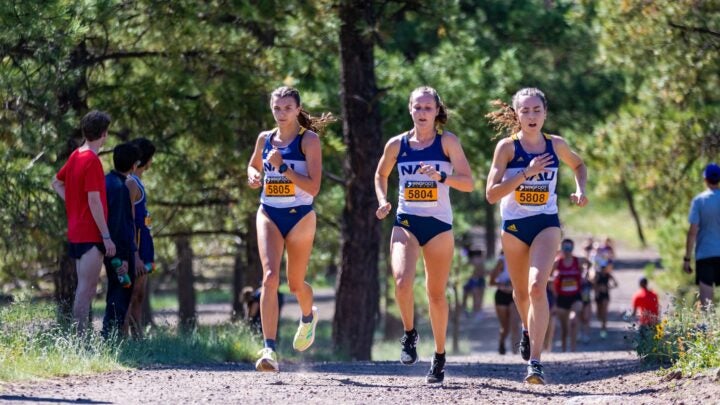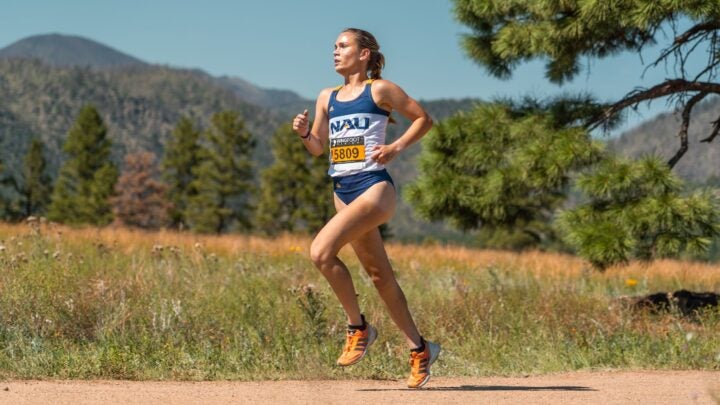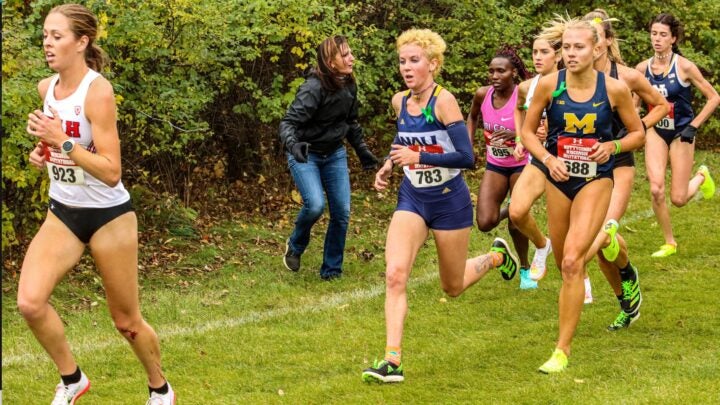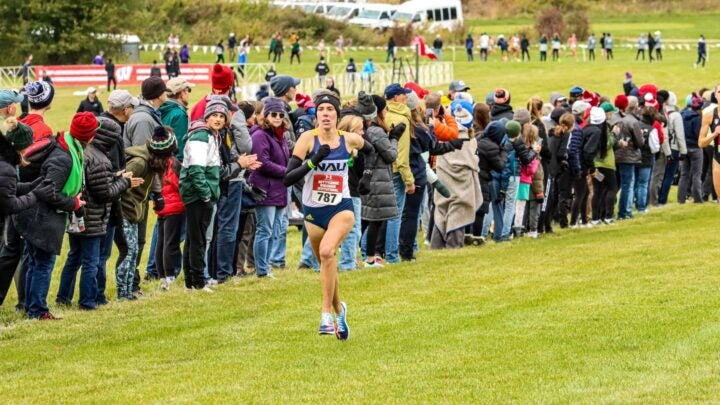Products You May Like
Get access to everything we publish when you
sign up for Outside+.
During the second week in October, the 18 members of Northern Arizona University women’s cross-country team gathered in a windowless meeting room just off the campus’s outdoor track. They chit-chatted about a fartlek workout they each did on their own that morning (there was a Nikki Hiltz sighting on Lake Mary Road), while they waited for their coaches to start a discussion about the Nuttycombe Wisconsin Invitational—a key race they were traveling to the following day.
In front of a white board, Mike Smith, NAU director of cross country and track and field (full disclosure: the author’s running coach from 2008-2015), and Becca Pflugrad, assistant distance coach, began their talk with the basics: a 2 p.m. departure, an expectation that traveling team members will go to classes in the morning, and an easy run for everybody first thing.
The Nuttycombe race is an important checkpoint during the NCAA regular season. The field size and depth of competition mimic that of the national championship meet, and the Nuttycombe results have come to signal what to expect in the postseason races.
This year, the NAU women find themselves in uncharted territory. Three weeks prior to this team meeting, the squad turned heads by placing second at the Cowboy Jamboree, an early-season race on the same Oklahoma State University course that will host the NCAA championships on November 19. Two runners—Elise Stearns and Annika Reiss—finished in the top ten (fifth and sixth, respectively), followed by Taryn O’Neill (22nd), Bryn Morley (27th), and Jesselyn Bries (28th). The team came into the Jamboree ranked 22nd nationally, but the performance buoyed them to fourth in the U.S. Track & Field and Cross Country Coaches Association poll, the highest in NAU women’s program history.
It seems like it should have always been this way, this high performance—but it never has. The women’s program has long existed under the shadow of the NAU men’s cross-country team, which has won five national championship titles in the past six years. The same scholarships, the same coaches and training philosophies have never catapulted the women into the national conversation or afforded the program the same level of excellence as the men. When Smith and Pflugrad arrived in 2016 from Georgetown University, where Pflugrad was an athlete and Smith was the director of cross country and track and field, they had to sell female recruits a vision of what they hoped the NAU women’s program could become.
“You’d be on a recruiting call with a four-minute miler high school guy who was thrilled to talk with you and then 30 minutes later, you’re calling a really developmental high school girl who’s like, ‘No, sorry. I’m good,’” Smith says, during an interview at a Flagstaff coffee shop. “It was pretty demoralizing.”
Nonetheless, in 2017 five new female athletes showed up, took a chance, and started laying the groundwork for what the team might become, given a lot of attention and nurturing. “Initially, it was kind of like running a high school team, literally teaching the basics of culture and training,” Smith says. “I always think of the first people that said ‘yes’ to coming here, because we couldn’t even show them the dorms on recruiting visits—we didn’t have anybody who could host them. I have a lot of gratitude for those first couple of classes.”

Protecting Energy
Those women have all graduated now, but their legacy is starting to take hold this season. The Cowboy Jamboree results in September were a promising development, though during that team meeting it was impossible to predict how it would translate in Wisconsin, up against the Division 1 powerhouses like North Carolina State and New Mexico.
In Oklahoma, NAU started the 6K race aggressively to claim good positioning and held on, resisting the mid-race panic when things inevitably got difficult. Really difficult. But these women had committed to running for each other, as a team, ahead of individual goals—a strategy and an ethos that has taken years to cultivate.
“It gets harder to execute those elements when the stage gets bigger, when the pressure feels greater, when there are more eyes on you,” Smith told them during a team meeting. “We’re going to let go of all that—we’ve gotta make sure that we’re not feeling like we have to back something up or earn the ranking or prove anything to people. Guard against that and protect the initial energy that got us here.”
That “initial energy” is a simple curiosity about how many teams NAU could beat, rather than predetermining how the team was supposed to place. Going into a race with open-ended curiosity is different from defending a position and proving it belongs to you. The latter is a trap, something these women didn’t want to bring to Wisconsin.
“The same athletes, with the same fitness and same competition see that these results get harder as we start changing the narrative around what has to happen,” Smith says.
Three days later, they finished third at the Nuttycombe race with mixed emotions. It was another impressive result that bodes well for later meets, behind NC State, the 2021 national champions, and New Mexico, who placed third at NCAAs in 2021. NAU was led again by Stearns, a fourth-year runner coming into her own, who finished third behind NC State’s Katelyn Tuohy and Kelsey Chmiel.
While the rest of the team claimed fine positioning among the 260 athletes, they didn’t execute as flawlessly as they had in Oklahoma, entering the pain cave in Wisconsin earlier than they did at the Cowboy Jamboree and it showed. “There was a lot of bleeding between 2K and 4K,” Pflugrad says. “But the good news was that they didn’t let it unravel them.”
Taryn O’Neill, a 2020 All-American, the 2021 Mountain West regional champion, and two-time Big Sky conference champion, is in her fifth and final season at NAU. She placed 64th at Nuttycombe, third for the team, after taking a break over the summer and coming back to training gradually this season.
“It was definitely not what I’m capable of right now and I think a lot of the girls on the team had a similar response,” O’Neill says. “That being said, for most of us to have an off-day and still place third, I think it just goes to show the spot that we’re in this season. We needed something like that to really remind us that this stuff is really hard.”
RELATED: Splits:

No Judgment
O’Neill, who is from Kelowna, British Columbia, transferred to NAU from Villanova in 2019, feeling more comfortable in the mountains and in a program that had room to grow. She has openly discussed the mental health issues she’s coped with during college, including an eating disorder and depression, which led to a rocky start to her time in Flagstaff. But over time she’s come to rely on her coaches and teammates for support and community, which she’s found essential for sustaining her happiness.
“They just seemed to understand and prioritize personal wellbeing and personal growth over any sort of athletic accomplishment,” O’Neill says. “I don’t get that vibe on other teams, so I feel like we have something pretty special. Whenever my mental health gets really bad, I shut the world out and the team makes it pretty hard to do that, which is a good thing.”
It’s no secret that female athletes at the collegiate level are highly susceptible to anxiety and depression, as well as body image and eating disorders. In recent years more women have come forward about how the win-at-all-costs mentality, and abusive coaching that prevails in some programs have exacerbated mental illness and resulted in long-term physical harm. Antiquated practices like public weigh-ins and body fat tests have led plenty of athletes to serious health consequences later in life.
The NAU women are not immune to many of these struggles, but they say that they aren’t afraid to address them, either. The ability to confide in each other is the difference, they say. “Practice has been, some days, for me and other people, the only thing getting me through the day—getting to see everybody,” says Morley, who’s in her fifth year.
It’s taken years to develop that kind of relationship between team members—becoming a close-knit group didn’t come naturally at first, some of the senior members say. The coaches have worked on developing open dialogue with the athletes, guiding them to professional help and resources on campus and in town when any issues are outside of their realm of expertise.
“You’re going to see your college coach more than any other adult while you’re in college. They see me and Becca six days a week for four hours at a time, for four years,” Smith says. “We have to develop these trusting relationships where they know that we have their best interests in mind. When you create that trust, you can address the problems openly and honestly.”
Through her own experiences as a D-1 runner, Pflugrad has mirrored the coaching strategies that she valued during her time as an athlete. Had she not followed this career path, she wonders if she would have become a teacher—and she sees a large part of coaching is educating.
“Our first priority is making sure that they’re happy and thriving as people and in school. That will just naturally translate to the track,” she says. “They truly feel cared for whether they perform well or not. This career is an awesome way to help young women in this really transformative time of life.”
Meagan Van Pelt, who is also in her fifth and final season, was drawn to that kind of coaching when she was graduating from high school in Phoenix, Arizona, unsure what role running would play in her college life. She welcomed a chance to find out how good she could be, without a pressure-cooker environment.
“They truly let college be the place to discover who you are and what you value and how you want to be present in your life. No one gets reduced. No one gets cut. I was injured and I was always given the chance to come back,” Van Pelt says. “You can come out of this program being a whole different person—Flagstaff and NAU let you be who you want to be without judgment.”

Gradual Climb
The trick will be how NAU preserves this culture as it rises through the ranks. This squad places emphasis on staying relaxed, having fun, and running for each other. If you visit the team tent before the gun goes off, you may mistake it for a party—typically All American Rejects or Taylor Swift blasts from a speaker, tension is low, and there’s not an AirPod or headphone to be found.
“We’ve learned how to balance both holding ourselves to extremely high standards but also just having fun with it,” Stearns says. “I’ve had high school teammates that are Division 1 runners now, too, who have texted me after a meet to say, ‘Your tent seemed like so much fun. I really liked your music.’”
Beyond keeping the atmosphere loose, this is also a group that was brought into high-level training at 7,000 feet gradually. They didn’t start out doing the double tempo runs they do now (“double T day,” as it’s called). They were given the time to slowly adjust, building volume and intensity as their circumstances and bodies allowed.
Stearns came to NAU as a graduate of Hellgate High School in Missoula, Montana, unsure if she’d even liked running in college. Like most of the recruits, she was a low-mileage athlete with plenty of potential to develop, if she wanted to. As it turns out, she wanted to. Within two years she’s up to about 70 miles per week (and touched 80 during the summer) and handling workouts better than ever, which has produced big jumps in her performances.
“I trained during the summer with that Nuttycombe race in mind and being excited for it,” Stearns says. “I thought I would be really nervous but I translated it all into excitement. I told myself, you’re ready for this, let’s just make it fun as much as you can. The training has given me confidence and shown me that I’m strong enough to handle it.”
Smith believes that first-year athletes need enough time to adapt to the demands of student-athlete life and training in Flagstaff. It often takes three or four years to see this patient work pay off. The location, though challenging, reduces injuries, he believes—they have to slow down because of the altitude, and there are hundreds of miles of soft-surface trails to run on.
“We can develop you aerobically in really safe ways instead of seeing how many miles you can run until your bones break,” Smith says. “If we can keep you healthy, you’re going to find out what’s possible. In seven years I can count on one hand the number of bone stress injuries we’ve had. That’s not normal.”
Almost every day this team of women who have spent this fall making school history enter a new $46-million Student-Athlete High Performance Center, where they lift in an 11,500-square-foot weight room and take to a half-dozen Woodway Treadmills, housed in a chamber that can simulate conditions from sea level to 12,000 feet.
On the way to the locker rooms, snack area, academic study rooms, and an auditorium with an unimpeded view of the San Francisco Peaks through a 60-by-40-foot glass wall, they pass by a large case in the middle of the lobby, where five NCAA championship trophies are showcased, each belonging to the NAU men’s cross country team.

The women have yet to add to the display—the one and only time they made the podium was in 1991, finishing third. Last year they placed 23rd and in 2020 they finished 11th. On Friday at the Big Sky championships, they took their 24th conference title, led again by Stearns, who placed first. Now it’s on to the Mountain Regional championships on November 11 in Albuquerque, one of the toughest regions in the country, where they’ll face teams from New Mexico, BYU, and Colorado.
“This is going to be a season that they’re going to remember for the rest of their lives, no matter what happens,” Pflugrad says. “The way they come to practice every day, the way they’re pouring into each other as teammates, the way they’re approaching these races with curiosity and excitement of getting to see what they can do—that’s what’s going to put them in a position where they belong, with the top teams.”
Soon it’ll be back to Oklahoma for the NCAA championships, where maybe they’ll undoubtedly turn some heads again. But no matter where they place, they’ve finally set a new standard for NAU women’s cross country—one that ultimately has little to do with their national ranking.
“I think that class above me—those five who have graduated now,” O’Neill says, “if they could see just how different the team is now, I think they would be very proud of all the work that they put in is paying off.”
